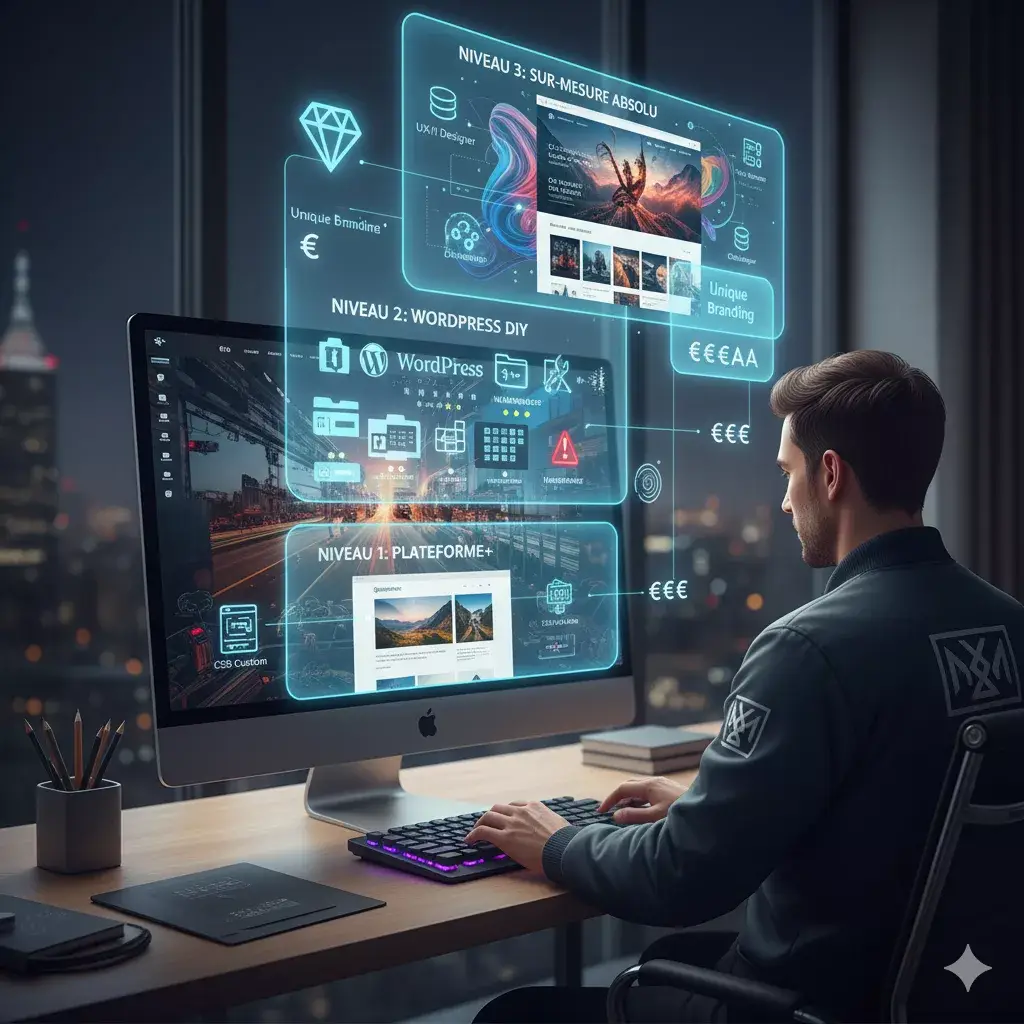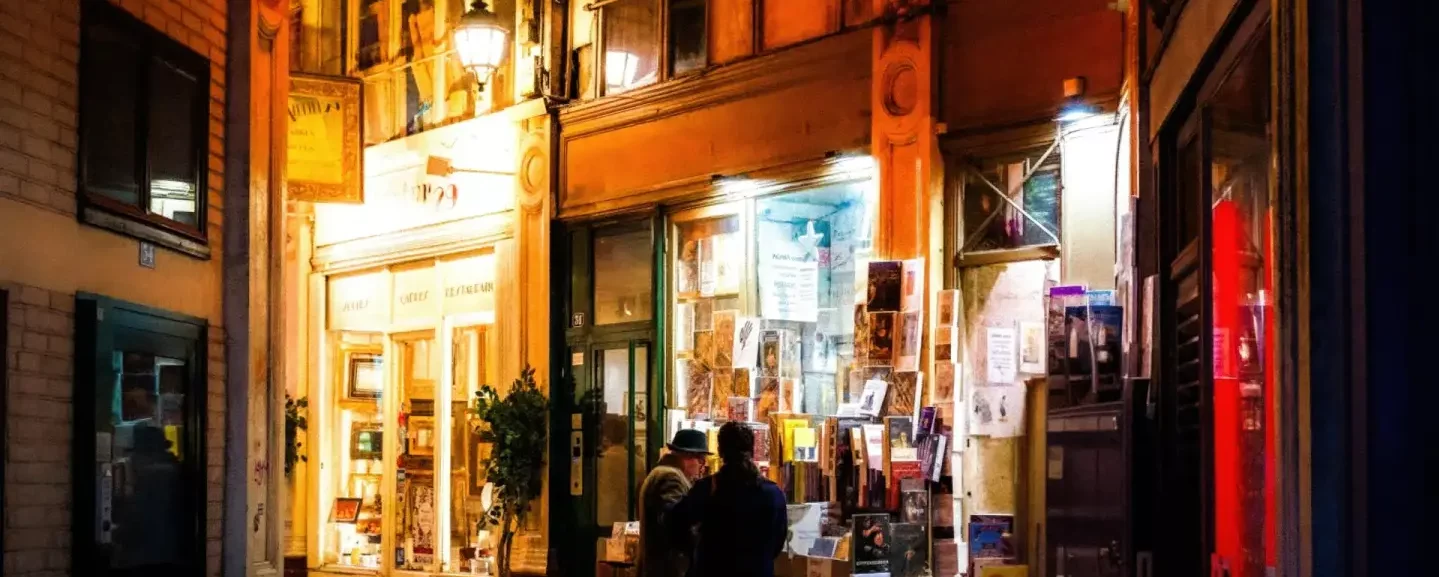
Preamble: In the previous article, we analyzed hosting platforms (Pixieset, Squarespace). They offer an excellent solution: simplicity, efficiency, and an optimized workflow. However, they come with a hidden cost: homogeneity. A discerning eye recognizes a Squarespace template or a Pixieset gallery from a mile away. The desire to have a website that “is unique and reflects one’s image” is not a technical endeavor, but one of branding. It is the ambition to transition from an efficient artisan to an artist with a distinct visual signature. However, this pursuit of uniqueness is a complex, costly, and arduous path.
I. The Strategic Interest: Why Aim for Uniqueness?
The interest is not functional; it is psychological and commercial. A unique website does not display your photos better than a well-designed Squarespace site. However, it alters the perception of the viewer.
The Advantages (The Rationale):
- Differentiation (Branding): This is the primary advantage. You stand out from the crowd. A visitor (art director, high-end wedding client) who views 10 portfolios consecutively will remember yours because their browsing experience (UX/UI) was unique.
- Credibility and High-End Positioning: A custom-built website is an outward sign of success and professionalism. It implicitly justifies higher rates.
- Custom Features: You are no longer limited by what the platform offers. Do you desire an interactive art print price calculator? A client area with highly specific functionalities? Scroll-triggered “sound design”? Everything is possible.
- Advanced SEO Optimization: You have complete control over the code structure, loading speed (Core Web Vitals), and semantic architecture, allowing for potentially much more powerful search engine optimization (SEO) than the “bloated systems” of platforms.
The Weaknesses (The Constraints):
- Cost: Uniqueness is a luxury. It comes at a price, and a high one. Custom solutions are exponentially more expensive than “off-the-shelf” options.
- Maintenance: This is the major constraint. A custom-built website is not maintained by a team of 100 engineers (like Squarespace). It is you (or your service provider) who must manage updates, security vulnerabilities, and browser bugs.
- Rigidity (Paradoxical): A custom-built website can be more difficult for you, the photographer, to update. If the “back-office” (CMS) is poorly designed, adding a simple gallery can become a technical nightmare, whereas Pixieset accomplishes this in 3 clicks.
- The Risk of “Poor Uniqueness”: Unique does not equate to “good.” A unique design that is not ergonomic, is slow, or confusing (poor UX) will have negative repercussions and deter clients more quickly than a basic but effective template.
II. The Solutions: The Scale of Customization (Difficulty, Costs, Solutions)
“Unique” is a spectrum. Here are the solutions, categorized by increasing levels of difficulty and cost.
Level 1: Platform “High Customization”
This offers the best of both worlds: the security of a platform (Squarespace, Pixieset) pushed to its limits.
- Method: One chooses a platform renowned for its flexibility (Squarespace excels in this regard) and injects custom CSS or code (via “Code Injection”) to modify fonts, spacing, colors, and behaviors that the basic template does not allow.
- Difficulty: Medium. One must learn the basics of CSS or engage a “Squarespace Specialist” for a few hours.
- Cost: Low. The subscription price (€20-40/month) + €300 to €1,000 (one-time service) if you engage a freelancer for customization.
- Benefit: You retain ease of use, included maintenance, and client galleries, but with a “look” that stands out.
Level 2: “Control” via a Flexible CMS (WordPress + Page Builder)
This is the most popular “Do It Yourself” (DIY) solution for those who desire almost complete control without knowing how to code.
- Method: You manage your hosting (e.g., SiteGround, OVH). You install WordPress.org (free). You purchase a “Page Builder” (page constructor) such as Elementor Pro or Divi. You start with a blank page and visually construct your site using drag-and-drop.
- Difficulty: High. The learning curve is steep. Everything must be managed: security (crucial!), backups, plugin updates, performance (cache and image optimization).
- Cost: Medium. Hosting (€5-15/month) + Page Builder (approx. €50-100/year) + Gallery Plugins (approx. €50/year).
- Constraints: It is a “bloated system.” These builders generate heavy code, the site can become slow, and a broken plugin can take the entire site offline. Maintenance is your responsibility.
- Time: Allow several weeks, or even months, to learn and achieve a professional result.
Level 3: the “Absolute Customization” (Specific Development)
This is the only true path to a 100% unique website. You do not start with a template; you start with an idea.
- Method: You engage professionals. The process is broken down as follows:
- UX/UI Designer: They create mock-ups (wireframes, then design) using software such as Figma. They define the “uniqueness” of the experience.
- Developer: They translate these mock-ups into code.
- Which technologies?
- Custom WordPress: The developer creates a theme “from scratch” (from zero) and utilizes a tool such as ACF (Advanced Custom Fields) to create an ultra-simple back-office that is 100% tailored to your needs (e.g., a simple “Add Gallery” button). This is the most robust solution.
- Webflow: A “visual” platform for developers. Cleaner than WordPress+Elementor, but requires development skills.
- Headless CMS: (e.g., Strapi, Sanity) coupled with a front-end (React, Vue). This offers peak performance, but is the most complex and expensive option.
- Difficulty: None (for you) / Extreme (for the service provider). Your challenge lies in managing the project and meticulously drafting your specifications.
- Cost: Very High. For a custom photographer website (Design + Development + CMS) created by a quality agency or freelancer, the entry cost ranges from €3,000 to €15,000 (one-time service), plus a maintenance contract (approx. €50-150/month).
III. The Investment: Time, Costs, and Returns
Creation Time:
- Level 1 (Platform+): 1 to 3 days.
- Level 2 (WordPress DIY): 1 to 3 months (including learning).
- Level 3 (Custom): 2 to 6 months (from initial brief to launch).
Time Savings (Ultimately):
This is the most crucial point.
- A Level 2 (WordPress DIY) website is a time sink. You spend your time on maintenance instead of photography. This is often a miscalculation.
- A Level 3 (Custom) website that is well-designed offers phenomenal time savings. If your CMS is designed with you in mind, you can update your portfolio in 2 minutes. If you integrate your client galleries and e-shop, the website works for you and automates tasks (invoicing, file delivery).
Potential Returns:
- Positive:
- Increased perceived value.
- Access to more prestigious clients (luxury, advertising, high-end weddings) who are receptive to this brand image.
- Personal pride, which strengthens your confidence and commercial discourse.
- Improved SEO (if executed well).
- Negative:
- The “financial drain”: a custom-built website that malfunctions and requires costly repairs.
- Design failure: a unique site that no one understands (poor UX), leading to a drop in your conversion rate.
- The “golden cage”: being dependent on a service provider who charges exorbitant fees for the slightest modification.
IV. Conclusion: “What to Do?”
- Self-assessment: Do you truly require a unique website? Or do you require an effective website? For 90% of photographers, a Level 1 (well-customized Pixieset or Squarespace) solution is the most cost-effective and intelligent choice. It allows you to focus your efforts on your craft (photography) rather than web maintenance.
- The Middle Ground (Risky): The Level 2 (WordPress DIY) option is recommended only if you possess a passion for (and time to dedicate to) web technology. Otherwise, it is the quickest path to exhaustion.
- The Strategic Investment: The Level 3 (Custom) option is relevant only if you are an established photographer. If your business already generates a comfortable turnover and you wish to advance to the next level (to capture the luxury, art, or advertising market), then a custom-built website becomes a branding investment, akin to an exhibition print or a physical studio.
My advice: Begin with a “Level 1” solution. Professionalize it to the fullest extent possible. If, and only if, you perceive that your website limits your business growth and your budget allows, then plan for a “Level 3” solution as a genuine business project.
This post is also available in:
French
